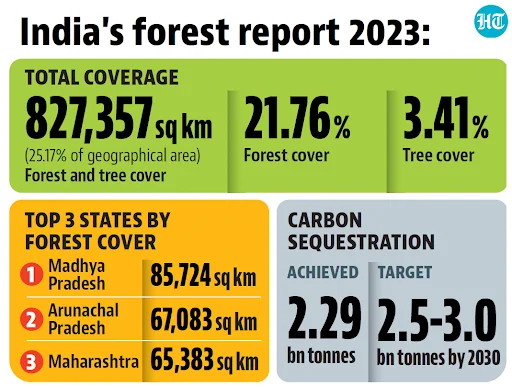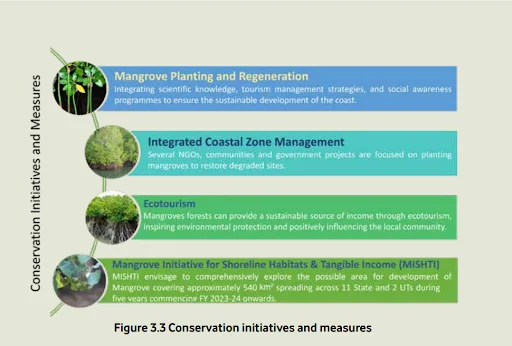Introduction of ISFR 2023
- The India State of Forest Report (ISFR) 2023 was officially released by the Minister for Environment, Forest, and Climate Change at the Forest Research Institute in Dehradun.
- Published every two years by the Forest Survey of India (FSI) since 1987, the ISFR 2023 offers a comprehensive assessment of the nation’s forest and tree resources, based on satellite data and extensive field surveys.
- This 18th edition provides valuable insights into various aspects of forest health, carbon stock, tree cover, forest fires, and agroforestry, serving as a crucial resource for policymakers, environmentalists, and researchers.
Read also: India-China Special Representative Meeting | UPSC
Key Highlights from ISFR 2023
- The ISFR 2023 presents an in-depth look at India’s forest and tree resources, offering detailed statistics and trends. Here are the essential features:
- Forest and Tree Cover in India: India’s total forest and tree cover spans 8,27,357 sq. km, covering 25.17% of the country’s geographical area. The breakdown is as follows:
- Forest cover: 7,15,343 sq. km (21.76%)
- Tree cover: 1,12,014 sq. km (3.41%)
- Increase in Forest and Tree Cover: The latest report shows a net increase of 1,445 sq. km in forest and tree cover since 2021. This includes:
- Forest cover: An increase of 156 sq. km
- Tree cover: An increase of 1,289 sq. km
- States with Significant Growth: The states with the largest increase in forest and tree cover are:
- Chhattisgarh: +684 sq. km
- Uttar Pradesh: +559 sq. km
- Odisha: +559 sq. km
- Rajasthan: +394 sq. km
- The top three states with the highest increase in forest cover are:
- Mizoram: +242 sq. km
- Gujarat: +180 sq. km
- Odisha: +152 sq. km
- Areas with the Largest Forest and Tree Cover: The states with the largest areas under forest and tree cover are:
- Madhya Pradesh: 85,724 sq. km
- Arunachal Pradesh: 67,083 sq. km
- Maharashtra: 65,383 sq. km
- Mangrove and Bamboo Cover
- Mangrove cover: India’s mangrove areas are recorded at 4,992 sq. km, crucial for coastal protection and biodiversity.
- India ranks as the world’s third richest nation in terms of mangrove plant diversity, trailing behind Indonesia and Australia. India has 46 genuine mangrove species spanning 14 families and 22 genera.
- Bamboo-bearing area: India’s bamboo area spans 1,54,670 sq. km, marking an increase of 5,227 sq. km since 2021.
- Growing Stock and Carbon Sink: The total growing stock of forests and trees outside forests is 6,430 million cubic meters. India has already achieved 2.29 billion tonnes of additional carbon sequestration. This brings India closer to its Paris Agreement commitment of creating 2.5 to 3.0 billion tonnes of additional carbon sink by 2030.

Key Concerns Highlighted in ISFR 2023
- Despite positive trends in forest cover, the ISFR 2023 also brings attention to several significant challenges that continue to hinder forest conservation in India:
- Loss of Mangrove Cover: There has been a decrease of 7.43 sq. km in mangrove cover compared to 2021, with significant losses in Gujarat (36 sq. km) and the Andaman and Nicobar Islands (4.65 sq. km).
- Decline in Forest Cover in Northeast India: The northeastern states of India have seen a continued decrease in forest cover, with 327.30 sq. km of forest lost in the region during the assessment period.
- Loss of Forest Cover in the Western Ghats: The Western Ghats, an ecologically sensitive region, has witnessed a loss of 58.22 sq. km of forest cover since 2013, with areas designated as eco-sensitive zones suffering the most.
- Decline in Dense Forests: India has lost approximately 24,651 sq. km (6.3%) of dense forests since 2003, including 3,913 sq. km in the last two years, which is a major cause for concern, especially as dense forests are crucial for biodiversity and climate stability.
- National Forest Goals Not Achieved: The National Forest Policy of 1988 set a target of having one-third of the country’s land area under forest or tree cover. However, the current forest cover stands at 25.17%, still falling short of this goal.
- Plantation vs. Natural Forests: While plantation areas have expanded, experts have raised concerns about the over-reliance on monoculture plantations, which lack the biodiversity and resilience of natural forests. These plantations are more vulnerable to pests, diseases, and climate change.
See more: Understanding Sexual Harassment of Women at Workplace | UPSC
Factors Behind the Increase in Forest Cover
- Community Participation: The active involvement of local communities through initiatives like Joint Forest Management Committees (JFMCs) has been key to the success of conservation and reforestation programs.
- Technological Advancements: The use of remote sensing technologies and forest monitoring systems has greatly enhanced the efficiency of forest management and restoration activities.
- Growing Public Awareness: Rising awareness about the importance of forests and biodiversity, coupled with growing participation in ecotourism and CSR initiatives, has led to increased public support for conservation programs.
- Afforestation Programs: Government-led initiatives like the National Afforestation Programme (NAP) and Green India Mission (GIM) have played a crucial role in afforestation and reforestation efforts.
- Promotion of Agroforestry: Programs like the Sub-Mission on Agroforestry (SMAF) have encouraged farmers to plant trees alongside crops, contributing to an increase in tree cover.

Measures to Further Enhance Forest Cover
- Public-Private Partnerships (PPP): Enhanced collaboration between the government, industries, and NGOs can lead to larger, more effective green projects. The Toyota Green Wave Project in Japan demonstrates the potential of such partnerships in supporting forest restoration efforts.
- Incentives for Tree Planting: The government could provide financial incentives and tax benefits to encourage individuals and organizations to plant more trees, following models like China’s Grain-for-Green Program, which compensates farmers for converting agricultural land into forests.
- Establishing Seed Banks and Nurseries: Establishing seed banks and tree nurseries across the country will ensure a steady supply of high-quality planting material for restoration efforts. The Millennium Seed Bank Project in the UK is an excellent example of how seed preservation can aid forest restoration globally.
- Restoration of Degraded Lands: Large-scale land restoration efforts should be undertaken to rehabilitate degraded lands, with programs focusing on soil restoration and watershed management. For example, Ethiopia’s Tigray Reforestation Project has shown success in reclaiming arid lands through tree planting.

